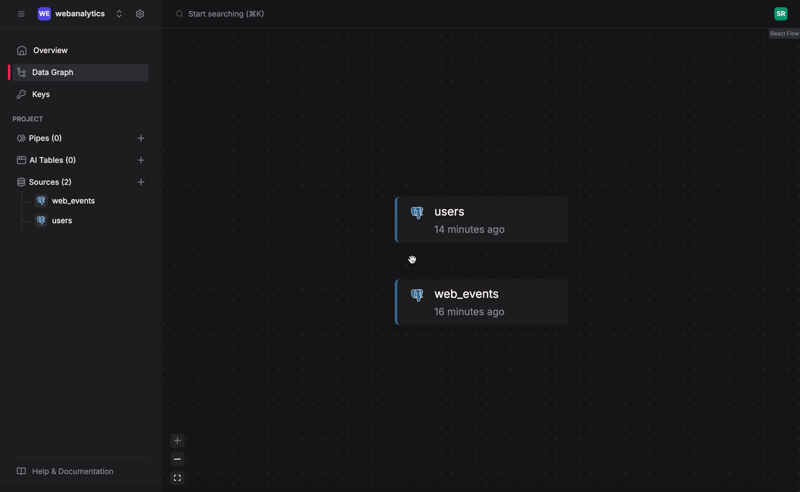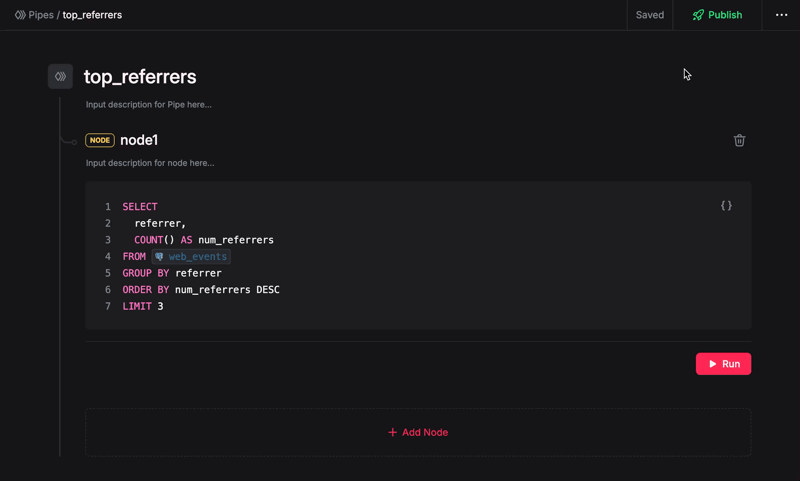UI
Creating Draft pipe
Navigate to “Pipes” on the left menu column, and click on ”+”: Enter a name for this query, then press “Create”.
Here, you have a node where you can enter a single SQL
Enter a name for this query, then press “Create”.
Here, you have a node where you can enter a single SQL SELECT statement to query your tables directly.
These SQL statements can interact with your tables in the same way as standard SQL tables, with additional AI columns you can leverage for deeper insights.
For example, to get the top referrers as in our quickstart example we can run the following command.
Creating Published pipe
Click on “Save” to save this node, and “Publish” to publish it as an endpoint: That’s it, your draft pipe just became a publihsed pipe, you can go to view endpoints and use any of the Javascript, Python or curl command to ping the endpoint.
Creating Incremental Materialized pipe
Let’s say we want to get the signup, purchases and page_views metrics along with total_events from the web events data. we could run the query below to get the metrics per day.Note the materialized pipe example uses
countIfState() instead of countIf().Airfold uses ClickHouse under the hood which requires appending State to aggregate functions when used in a materialized pipe.Fortunately, Airfold does it automatically when materializing a draft pipe using af materialize <pipe_name>.Learn more about Materialization in ClickHouse, about the *State combinator.
Creating Refreshable Materialized pipe
Let’s consider example, if we want to get the top_pages visited by unique visitors per page_url, we can do it by the following command.
CLI
Creating Draft pipe
These are the starting point for all pipes, similar to database views in functionality. They cannot be referenced by other pipes using theFROM clause.
Draft pipes are temporary and primarily used for development. Once finalized, a draft pipe can be transitioned into either a published or a materialized pipe, but not both.
draft_pipe.yaml
A brief description of the pipe’s purpose or functionality. Optional.
The sequence of nodes within the pipe. Each node represents a stage in data processing.
Specifies the target source for appending the incremental results. When set, it converts the pipe into a materialized pipe. This option cannot be used with
publish and requires the final node’s schema to match the provided source schema. Optional.The endpoint name where the results are published, turning the pipe into a published pipe. This option cannot be used with
to. Optional.A list of parameters for parameterizing node SQL queries through Jinja2 templating e.g.
{{ param }}. These parameters are passed via the API and can be used to dynamically alter the pipe’s behavior. Optional.A refresh schedule definition. Used in refreshable materialization where the pipe is executed on schedule. Optional.
Creating Published pipes
This creates an API endpoint that serves the result of your pipe, the result is accessible in JSON, NDJSON, CSV, and Parquet formats. To publish a draft pipe, assign an endpoint name to thepublish field.
Published pipes can parameterize their SQL using Jinja2 via the params field.
Unlike draft pipes, published pipes can be accessed (via FROM) by other pipes.
published_pipe.yaml
Creating Incremental Materialized pipe
Differing from the batch nature of draft and published pipes, materialized pipes stand out for their ability to incrementally transform data as it is ingested and append their results to a designated source. To materialize a draft pipe, set theto field to the name of the target source.
Although materialized pipes themselves cannot be accessed (via FROM) by other pipes, the source they write to is accessible like any other source.
incremental_pipe.yaml
Note the materialized pipe example uses
countState() instead of count().Airfold uses ClickHouse under the hood which requires appending State to aggregate functions when used in a materialized pipe.Fortunately, Airfold does it automatically when materializing a draft pipe using af materialize <pipe_name>.Learn more about Materialization in ClickHouse, about the *State combinator.Creating Refreshable Materialized pipe
Some sources are batch in nature, likeprices table or products table.
And may be refreshed from a connector or any other external process.
To work with these sources efficiently and create transformations/queries use a "refreshable" materialization.
refreshable_pipe.yaml
Push
Push pipes to your workspace using the CLI commandaf push.For example, to push
draft_pipe.yaml:

